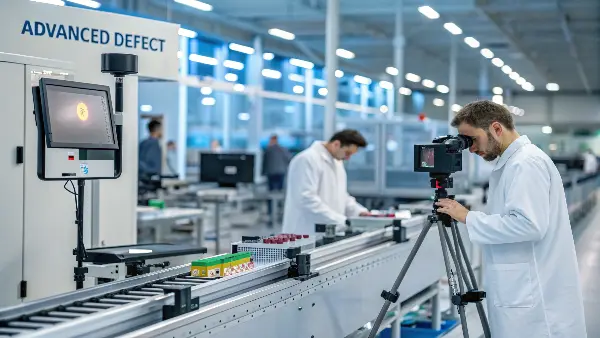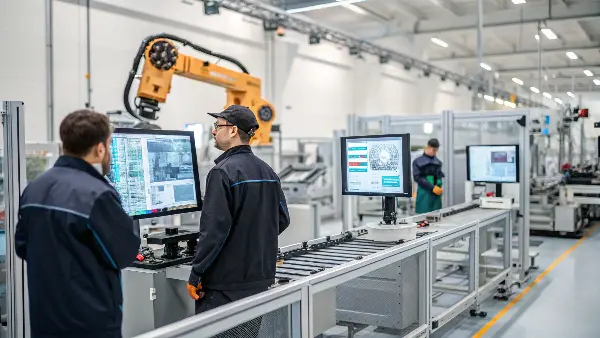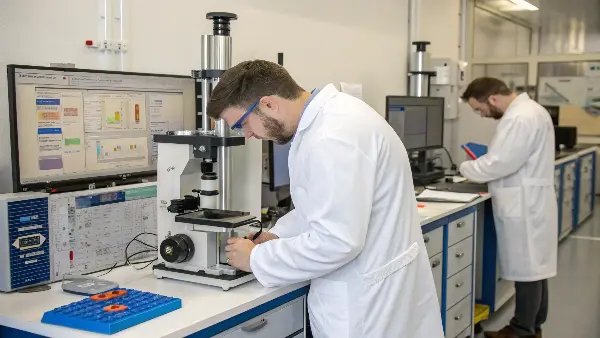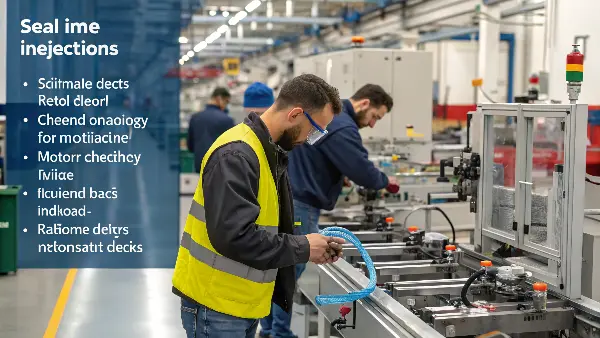Are you worried about receiving a shipment full of products with tiny flaws, cracks, or color inconsistencies? These defects can lead to customer complaints, bad reviews, and damage your brand’s reputation. Advanced detection technologies catch these issues before they ever leave the factory floor.
Advanced defect detection uses technologies like Automated Visual Inspection (AVI), X-ray scanning, and precise material testing. These systems use cameras, sensors, and software to identify imperfections in silicone, plastic, and electronic components that the human eye might miss. This process ensures every product meets strict quality standards, protecting your brand and satisfying your customers.

I’ve talked to countless brand owners who have been burned by inconsistent quality. A single bad batch can create a ripple effect of problems, from costly returns to the erosion of customer trust. It’s a nightmare scenario for any e-commerce entrepreneur. That’s why, as a manufacturer, we’ve invested heavily in technology that goes beyond a simple visual check. Understanding these systems is key to building a reliable supply chain. It’s time to pull back the curtain on how we ensure the products you sell are genuinely top-tier.
How Does Automated Visual Inspection (AVI) Ensure a Flawless Finish?
Manually inspecting thousands of units is slow, expensive, and prone to human error. An inspector might miss a tiny bubble trapped in the silicone or a slight color mismatch after a long shift, but you can be sure your most discerning customers won’t.
Automated Visual Inspection (AVI) uses high-resolution cameras and sophisticated AI software to scan every single product for cosmetic flaws. It compares each item to a "golden sample" or a digital standard, instantly flagging any deviations in color, texture, shape, or surface integrity. This ensures a level of consistency that manual inspection simply cannot match.

When we first integrated AVI into our production lines at PrivyPlay, the results were eye-opening. We started catching things that were almost invisible. Think about the common issues that can plague a silicone product. A tiny air bubble trapped just below the surface, a faint parting line from the mold, or a slight inconsistency in the matte finish. To a busy inspector, these might seem trivial. To a customer, it can feel like a sign of a cheap or defective product.
AVI automates this entire process with ruthless efficiency. Here’s a breakdown of how it works for different types of defects:
Key Areas Targeted by AVI
| Defect Type | AVI Detection Method | Importance for Your Brand |
|---|---|---|
| Surface Imperfections | High-resolution cameras scan for air bubbles, scratches, sink marks, or dust particles embedded in the material. | A flawless surface is critical for hygiene and the premium feel of the product. These defects can harbor bacteria or feel unpleasant. |
| Color & Finish Consistency | Spectrometers and specialized lighting check that the color (e.g., Pantone shade) and finish (matte, glossy) are uniform across the batch. | Ensures your branding is consistent. A customer buying a pink toy expects it to match the exact shade shown on your website. |
| Dimensional Accuracy | 3D scanners and cameras measure the product against its original CAD model to check for warping, incorrect size, or misshapen parts. | Guarantees that accessories, chargers, or other components will fit perfectly. It’s a core aspect of functional quality. |
By using machines for this repetitive but critical task, we not only improve accuracy but also speed up the entire quality control process. It allows our human team members to focus on more complex issues that require critical thinking, rather than trying to spot a microscopic flaw on unit number 5,000. For you as a brand owner, this means greater peace of mind and a product that consistently looks and feels premium.
Why Is Rigorous Material Testing Crucial Before Production?
Have you ever wondered if the "body-safe silicone" you’re advertising is truly what you’re getting? Sourcing a cheaper material might save a few cents per unit, but it could lead to product failures, safety concerns, and irreparable damage to your brand’s credibility.
Rigorous material testing happens before mass production begins. It involves a series of scientific analyses to verify that raw materials like silicone, ABS plastic, and TPE meet exact specifications for safety, durability, and texture. This proactive step prevents catastrophic failures and ensures every product is genuinely body-safe and built to last.

I learned a hard lesson about this years ago when working with a new supplier. We received a batch of material that felt slightly different. The supplier assured us it was the same grade. We went ahead, and halfway through the production run, we found the products were tearing easily. It turned out to be a lower-grade silicone blend. We had to scrap thousands of units. That’s why at PrivyPlay, we never take a supplier’s word for it; we test everything ourselves.
This isn’t just a simple stretch test. It’s a comprehensive evaluation that protects you and your customers.
The Core Pillars of Material Testing
-
Chemical Safety & Compliance: This is non-negotiable. We use techniques like Fourier-Transform Infrared Spectroscopy (FTIR) to verify the chemical makeup of the silicone. This confirms it’s 100% platinum-cured silicone and free from harmful substances like phthalates, BPA, and latex. We run tests to ensure compliance with standards like REACH and RoHS for our European clients. For you, this provides documented proof that your products are body-safe.
-
Physical & Durability Testing: Your customers expect a product that can withstand use. We put materials through a gauntlet of physical tests:
- Tensile Strength Test: We stretch the material until it breaks to measure its durability and resistance to tearing.
- Durometer Hardness Test: This measures the softness or firmness of the silicone (e.g., Shore A hardness), ensuring the product has the exact feel you designed.
- Wear & Abrasion Test: We simulate repeated use and contact with lubricants to make sure the material doesn’t degrade or become sticky over time.
-
Colorfastness & Stability Analysis: Nobody wants a toy that leaches color or changes its properties. We test colorfastness by exposing the material to heat, UV light, and various liquids to ensure the color remains stable and won’t stain fabrics or skin. This also verifies that the material won’t yellow or become brittle with age.
By front-loading our quality control with this intense material validation, we prevent problems from ever entering the production line. For a brand owner, this means you can confidently market your products’ safety and durability, knowing it’s backed by scientific data.
What Role Does In-Process Quality Control (IPQC) Play?
Catching defects at the end of the line is good, but preventing them from happening in the first place is much better. If you only inspect finished goods, an entire batch could be flawed due to one machine miscalibration, leading to massive waste and production delays.
In-Process Quality Control (IPQC) involves placing checkpoints throughout the entire manufacturing process, not just at the end. At each key stage—from silicone injection to motor assembly—operators and automated systems check the work. This real-time monitoring catches deviations as they happen, allowing for immediate correction and preventing small errors from escalating into widespread defects.

Imagine we’re making a vibrator. The process has multiple steps: molding the silicone body, soldering the electronics, assembling the motor, and sealing the unit. Without IPQC, a problem with the soldering on the first day might not be discovered until final testing a week later. By then, thousands of units could have the same fault. This is the costly and inefficient scenario that IPQC is designed to eliminate.
IPQC turns the production line into a series of quality gates. If a product doesn’t pass the checks at one stage, it doesn’t move on to the next.
Key IPQC Stages in Adult Toy Manufacturing
| Production Stage | IPQC Check | Purpose |
|---|---|---|
| Silicone Injection Molding | The first few units from a new mold (the "first article") are immediately checked for dimensional accuracy, flashing (excess material), and surface finish. | To confirm the mold and machine settings are perfect before starting the mass production run. |
| Motor & Electronics Assembly | Operators test the motor’s vibration strength, noise level, and function cycles at the assembly station. They also verify solder joint quality under magnification. | To catch faulty motors or bad electrical connections before they are sealed inside the product, making them impossible to repair. |
| Ultrasonic Welding / Sealing | The waterproof seal is tested on a sample of units throughout the day using pressure decay or water immersion tests. | To ensure the product’s waterproof rating (e.g., IPX7) is consistently being met. A failed seal can lead to total product failure. |
| Printing & Finishing | Any logos or markings are checked for alignment, clarity, and adhesion immediately after they are applied. | To prevent branding errors that can make an entire batch of products unsellable. |
This continuous feedback loop is what separates professional manufacturing from basic workshop production. It allows us to maintain stable, predictable quality throughout a run of 5,000 or 50,000 units. For you, this translates directly into reduced defect rates, more reliable delivery schedules, and the confidence that every component inside the product has been verified.
Conclusion
Ultimately, these advanced detection technologies are about one thing: building trust. They ensure the product in your customer’s hands is safe, reliable, and exactly as you promised. This protects your brand’s reputation, reduces costly returns, and builds the long-term loyalty that every successful business is built on.
